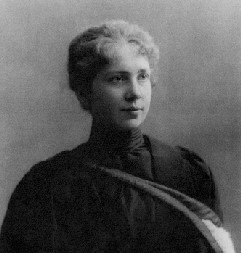
“It is amazing how many women were involved in the study of radioactivity during that period [the turn of the 20th century]. As well as Brooks, Gates, Gleditsch, Leslie and Szmidt, there were at least ten other women who authored or co-authored papers on the subject – a significant proportion of the researchers of the time.”
– Marlene and Geoffrey Rayner-Canham in Harriet Brooks: Pioneer Nuclear Scientist, 1992
Harriet Brooks was born in Exeter, Ontario in 1876, third of nine children in a commercial traveller’s family. Despite humble beginnings, determination and intelligence evidently ran in the family. Two of the girls won scholarships to McGill University; Harriet pursued sciences and Elizabeth did classics and mathematics. Both did very well, and received additional support to continue their education at McGill.
New Zealand physicist Ernest Rutherford arrived in Montreal in 1898, fresh from Cambridge University studying under physicist J.J. Thomson, to take up the chair of Macdonald Professor of Physics at McGill University. Rutherford was impressed by Brooks and she became his first graduate student. Her 1899 thesis “Damping of Oscillations in the Discharge of a Leyden Jar” was submitted towards a master’s degree in physics; Brooks was the first woman to receive this degree at McGill, awarded in 1901.
It was an exciting time in physics and chemistry. Radiation was discovered by Henri Becquerel in 1896, spurred on by Roentgen’s discovery of x-rays in 1895; Marie Sklowdowska-Curie and her husband Pierre discovered polonium and radium in 1898. Rutherford would win the 1908 Nobel Prize in Chemistry “for his investigations into the disintegration of the elements, and the chemistry of radioactive substances.” As student and then colleague of Rutherford, it was no wonder that Brooks began research with the radioactive emanations from uranium and thorium.
Brooks determined that a radioactive substance emanating from thorium was actually a lighter gas, later determined to be radon-220. This was a stepping stone on the path to Rutherford’s later radical pronouncement that radiation was often due to a change from one type of atom to another (transmutation). The results and analysis of this work were published by the Royal Society of Canada in 1901 as a joint paper by Rutherford and Brooks entitled “The New Gas from Radium”. As with all his colleagues and students, Rutherford gave credit where credit was due. He was also extremely supportive of women in science, treating them as professional equals: “women are often endowed with such a degree of intelligence as enables them to contribute substantially to progress in the various branches of learning” [Rutherford, letter to the Times, Dec 1920]. Rutherford and his wife May remained Brooks’ friends and supporters for the rest of her life.
Brooks left McGill in 1901, spending a year at Bryn Mawr women’s college in Pennsylvania, and then a year at the Cavendish Laboratory in Cambridge. She returned to McGill in 1903, where she continued her work with Rutherford before moving to New York City in 1904 to be a lecturer in physics at Barnard College for women. While there she became acquainted with Russian socialist writer Maxim Gorky and his entourage; Brooks accompanied them across the Atlantic, staying with them for a few months on the Italian island of Capri. In 1906 she went to Paris to work with Marie Sklodowska Curie; it is believed Brooks is the only person to have worked with the eminent scientists Rutherford, Thomson and Curie!
Unfortunately for science, Brooks gave up her research career when she married Frank Pitcher in July 1907; Pitcher had been one of Brooks’ lecturers during her undergraduate days at McGill, and he pursued her to the UK. Such were the times, when women were expected to look after the home and raise a family, and not pursue a career. However, theirs was a contented marriage, and Brooks continued to be very active with the Women’s Canadian Club and the University Women’s Club of Montreal. Brooks died in 1933; Rutherford, friend to the last, wrote a warm obituary in the Journal Nature.
The Society for the Preservation of Canada’s Nuclear Heritage are pleased to present a reading from the play “Wonder” about Harriet Brooks, by Toronto actor and playwright Ellen Denny. Denny, who is also Brooks’ great-great niece, received a grant from the Playwrights Guild of Canada to give this reading. It will take place at St Barnabas Anglican Church, 80 Glendale Avenue, Deep River at 7 pm on Friday September 20. Admission is free. Come join us for a dramatic exploration into the life of Canada’s first woman nuclear scientist.

